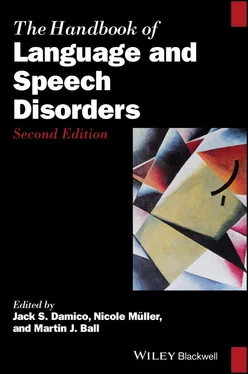1 ...7 8 9 11 12 13 ...52 Chapter 5presents a range of genetic syndromes that can affect language and speech. Vesna Stojanovik covers Williams syndrome and Down syndrome in detail, dealing with communication problems encountered by these speakers. She also points forward to the need for neurocognitive investigations of typical development to better understand the impairments found in genetic syndromes.
The final chapter in Part Iof the book also applies across the field of language and speech disorders. Bonnie Brinton, Martin Fujiki, and Robert Brinton Fujiki discuss the related areas of assessment and intervention in speech‐language pathology. They stress the importance of the social context of communication and the need to bear this in mind in both assessment and intervention. The chapter provides step‐by‐step advice on how to undertake these two aspects of the speech‐language pathologist’s practice, whatever communication problem is involved.
Part IIof the Handbook contains eight chapters dealing with different language disorders. In disordered language, various linguistic features can be disturbed, ranging from lexical items (e.g., word‐finding difficulties), through morphology and syntax (missing or incorrect affixes, sentence ordering difficulties) to semantics and pragmatics (inaccurate assigning of meaning to words, inappropriate use of language for a specific context). The chapters in this part of the book highlight which of these features are most important in the specific disorder under discussion, but they are not limited to this. For example, Patricia Prelock, in her chapter on autism, describes the linguistic markers of this disorder, but also discusses at length the recent changes to the classification of autism and highlights the importance of appropriate assessment and intervention. Paul Fletcher in Chapter 8outlines the typical trajectories of language acquisition, highlighting the wide variation in this process between individuals encompassing both vocabulary and grammar. He also points to good practice in assessment upon which to base appropriate intervention for children with various patterns of delay in language acquisition. Sandi Gillam, Sarai Holbrook, and Alan Kamhi in Chapter 9focus on the language disorder formerly termed “specific language impairment” and recently renamed “developmental language disorder.” The authors discuss the attempts to characterize the disorder and to discover the underlying causes, but also point to successful therapeutic strategies and the need for early intervention. In Chapter 10Louise Cummings addresses the pragmatics of language use. She illustrates many types of pragmatic impairments from a variety of speakers and discusses ways of assessing pragmatic impairment and intervention strategies.
In Chapter 11, Christine Brennan examines learning disabilities and their impact on the development of communication. In particular, she points to the different outcomes in adulthood between treated and untreated learning difficulties. The following chapter by Holly Damico, Jack Damico, and Ryan Nelson deals with literacy impairments. A development in this second edition has been to look more closely at writing rather than concentrating mainly on reading. The chapter stresses the importance of a meaning‐based approach to literacy teaching and intervention. Pamela Snow, Suze Leitão, and Natalie Kippin in Chapter 13describe communication outcomes in children who have suffered early life adversity. They note that such children may not only demonstrate less‐developed language skills, but will also have trouble in moving from speaking and listening to reading and writing. The last chapter of Part IIdeals with aphasia, a multifaceted disorder affecting both the production and perception of communication. Chris Code provides a detailed description of the many types of aphasia, and then concentrates on effective intervention strategies and the need to reintegrate people with aphasia into the community.
Part IIIof the Handbook also contains eight chapters, this time dealing with speech disorders. Speech disorders can range from impairments to the speech production mechanisms to problems with the organization of speech sounds in the linguistic system. Causes can range from delays to normal developmental pathways to acquired neurological damage due to stroke or other injury via genetic or surgical damage to vocal organs. The first three chapters deal with what are often considered the core areas of speech disorders. Thus, Chapter 15by Susan Rvachew describes child speech disorders; Ingo Hertrich, Hermann Ackermann, and Wolfram Ziegler deal with dysarthria in Chapter 16; and in Chapter 17, Adam Jacks and Katarina L. Haley cover apraxia of speech. The focus of Chapter 15is the heterogeneity of child speech disorders and the need to tailor intervention to the four main subtypes identified in the chapter. Hertrich and colleagues address the wide range of dysarthria subtypes and how they relate to specific neurological conditions. They include assessment and treatment methods, and how to measure the efficacy of therapy. As well as presenting the characteristics of apraxia of speech, Jacks and Haley argue for a common set of speech characteristics to be used in the diagnosis of apraxia of speech in both children and adults. They also discuss treatment approaches and describe those approaches that so far seem most efficacious.
Chapter 18by Kathryn Drager, Erinn Finke, and Elizabeth Serpentine deals with augmentative and alternative communication (AAC) for those with minimal or no speech abilities. The authors describe the range of AAC approaches and stress the need for individually tailored solutions to the communication needs of a highly variable clinical population.
The next two chapters cover two specialized areas of speech impairment: fluency disorders and voice disorders. In Chapter 19, John Tetnowski, Kathy Scaler Scott, and Brittany Rutland describe normal and disordered fluency. In particular they point to major advances in both understanding the underlying causes of stuttering and in assessment and treatment, since their chapter in the first edition of this Handbook . Richard Morris and Archie Harmon also present an updated chapter on voice and voice disorders. They too bring updated information to their description of voice disorders, their prevalence, and assessment and treatment issues.
The final two chapters of Part IIIdeal with speech disorders derived from genetic and medical factors. Debbie Sell, Valerie Pereira, Yvonne Wren, and Jane Russell have updated Russell’s chapter from the first edition of the Handbook with details of the most recent research in cleft palate and velopharyngeal impairments. They stress the importance of the role of the speech‐language professional in the team treating children with cleft palate, especially in terms of timing of surgical intervention and of speech therapy. Tim Bressmann, in Chapter 22, describes the various speech outcomes encountered in cases of laryngectomy, glossectomy, and disorders related to head and neck cancer. The author deals also with the surgical procedures undertaken with the various disorders, and describes the different rehabilitation options available to ameliorate the resultant impairments to speech production.
The final part of the Handbook contains four chapters dealing with communication disorders linked to cognitive and intellectual impairments. Chapter 23, authored by Carol Westby and Silvana Watson, covers attention deficit hyperactivity disorder (ADHD) and its impact on communication. The authors point to the increasing incidence of ADHD in children, and the need for research‐based interventions with this population. Margaret Lehman Blake, in Chapter 24, examines the range of communication problems encountered with right hemisphere brain damage. She describes difficulties this population may encounter with comprehension, and with managing conversation, and the need to develop treatment approaches based on the wide literature concerning this disorder.
Читать дальше












